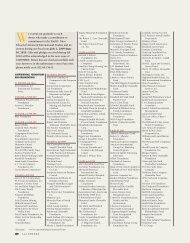Download Current Issue - SAIS
Download Current Issue - SAIS
Download Current Issue - SAIS
Create successful ePaper yourself
Turn your PDF publications into a flip-book with our unique Google optimized e-Paper software.
est growth rates and imports<br />
98 percent of its food.<br />
Yemen cannot afford to buy<br />
food, and the consequent<br />
social unrest will affect its<br />
neighbors.”<br />
In addition, Pearson<br />
said the “Greening Malawi”<br />
project will limit access to<br />
water inside Malawi and<br />
neighboring countries, in<br />
turn reducing the livelihood<br />
of many fishing communities.<br />
“The splitting of Sudan<br />
is another classic example<br />
of a fight for arable land and<br />
energy resources,” she said.<br />
Land grabbing is on the<br />
rise in Africa, Asia and Latin<br />
America. Richer developed<br />
countries are purchasing<br />
land in less-developed<br />
countries, and these investments<br />
are becoming a<br />
source of conflict because<br />
the buyers seldom recognize<br />
the rights of local stakeholders,<br />
domestic food security<br />
and rural development concerns.<br />
According to Pearson,<br />
unchecked “land grabs” will<br />
lead to more global food<br />
sovereignty conflicts.<br />
Another emerging source<br />
of conflict relates to urbanization<br />
emanating from<br />
internal migration from<br />
rural communities. “We<br />
have crossed the threshold,<br />
and there are now more<br />
people living in urban areas<br />
than in rural areas for the<br />
first time in history,” Pearson<br />
said. “Conflicts linked to<br />
food security will occur<br />
because of reduced food<br />
production in the abandoned<br />
rural areas.”<br />
The Role of Women<br />
The World Bank estimates<br />
that countries lose about 3<br />
percent of gross domestic<br />
product (GDP) annually if<br />
children are unhealthy when<br />
they grow to adulthood.<br />
Recent WFP studies in Latin<br />
America have put the figure<br />
at closer to 11 percent reduction<br />
in GDP. But a study by<br />
the International Food Policy<br />
Research Institute finds<br />
that across 63 countries,<br />
women’s education leads to<br />
more productive farming<br />
and results in a 43 percent<br />
decline in malnutrition.<br />
Pearson has long been<br />
passionate about educating<br />
girls. She cited that in<br />
2007, according to UNICEF,<br />
women did 66 percent of<br />
the world’s work and produced<br />
50 percent of the<br />
world’s food but earned only<br />
10 percent of the world’s<br />
income and owned only 1<br />
percent of all property.<br />
“Teaching young girls,<br />
providing them with nutritious<br />
meals, and giving them<br />
confidence and encouragement<br />
is the best investment<br />
a country can make,” she<br />
said. “Girls who remain in<br />
school marry later, postpone<br />
their first pregnancies and<br />
space their pregnancies,<br />
which breaks the cycle of<br />
undernourished pregnant<br />
adolescents giving birth to<br />
undernourished children.”<br />
Pearson said nutrition<br />
plays a critical role in a person’s<br />
life during a narrow<br />
window of time—the 1,000<br />
days that begin at the start<br />
of the mother’s pregnancy<br />
and continue through the<br />
second year of life. “The<br />
quality of nutrition during<br />
those 1,000 days can help<br />
determine whether a mother<br />
and child survive pregnancy<br />
and whether a child will<br />
contract a common childhood<br />
disease, experience<br />
enough brain development<br />
to go to school and to hold<br />
a job as an adult.” n<br />
Odette Boya Resta B’99, ’00<br />
is communications officer at<br />
the Bologna Center.<br />
Amici di Bologna 2011<br />
On June 4, nearly<br />
120 Bologna<br />
alumni from the<br />
classes of 1960 to<br />
2011—and even a couple<br />
of fresh faces from the class<br />
of 2012—gathered at 230<br />
Fifth’s glamorous rooftop<br />
garden and penthouse<br />
lounge in the heart of New<br />
York City for the fourthannual<br />
Amici di Bologna,<br />
an event reuniting Bologna<br />
Center professors and former<br />
students.<br />
The program began<br />
with opening remarks from<br />
Bologna Center Director<br />
Kenneth H. Keller and continued<br />
with an academic<br />
panel, including <strong>SAIS</strong><br />
Professors Mahrukh<br />
Doctor B’89, ’90, Mark<br />
Gilbert and Erik Jones B’89,<br />
’90, Ph.D. ’96. With a view<br />
of the Empire State Building,<br />
guests listened to a<br />
discussion about the implications<br />
of developments in<br />
Europe and South America<br />
on the Obama administration’s<br />
foreign policy agenda.<br />
The event featured<br />
two exciting door prizes:<br />
Peter Bracke B’81 and<br />
his wife, Rita, donated<br />
a weeklong stay in their<br />
Paris studio apartment, and<br />
Alison von Klemperer B’86,<br />
’87 contributed a dinner<br />
and a set of handcrafted<br />
aquamarine earrings and<br />
necklace. Young alumni<br />
Branislav Kralik B’09, ’10<br />
and Jamie Shellenberger<br />
B’10, ’11 were this year’s big<br />
winners.<br />
The event concluded<br />
with dessert and coffee, but<br />
for many amici the party<br />
flowed downtown and into<br />
the night.<br />
This year’s rooftop format<br />
encouraged fluid movement<br />
among guests, while the<br />
2010 sit-down dinner led to<br />
more sustained conversations.<br />
For the fifth-annual<br />
Amici di Bologna event in<br />
2012, the steering committee<br />
plans to offer the best<br />
of both worlds by organizing<br />
a sit-down dinner and<br />
an after-party option. Alla<br />
prossima!<br />
To help organize the<br />
2012 event, contact steering<br />
committee chair Tom<br />
Tesluk B’81, ’82 at ttesluk@<br />
gmail.com.<br />
Framed by the New York City skyline, Bologna Center Director<br />
Kenneth H. Keller, Portia Mills B’09, ’10 and guest, Professor<br />
Erik Jones B’89, ’90, Ph.D. ’96 and Bologna Center Director of<br />
Development Gabriella Chiappini<br />
2011–2012 65



